[rockyou id=121372813]
[ Text-and-picture posts from the six-month journey start at: https://kojin.wordpress.com/2008/07/25/introduction/ ]
This blog begins with “I. Introduction” and recounts more than six months driving around Perú in 2008. It contains many photographs of a variety of places, many quite off the beaten track. It used to begin with a slide show, but I noticed recently that the show is no longer supported, and will contact wordpress about how to replace it. In the meantime: please either go to the Introduction and read through at your leisure or, if you are interested in specific places, use the links below.
Thanks for visiting. btw, my current blog is www.soledadcanyon.blogspot.com
Photographs from that journey are on show at the Branigan Cultural Center in Las Cruces, New Mexico, from 7 June until the end of July, with an opening tonight, 7 June, from 5-7 p.m..
Peru Post I: Lima, 11-21 April 2008
Peru Post II – Lima -> Barranca > Trujillo
Peru Post III: Trujillo / Huanchaco, 23-29 April
Peru Post VI: Pacasmayo -> Pimental -> Piura
Peru Post VII: Piura -> La Encantada -> Chulucanas
Peru Post VIII: Chulucanas -> Huancabamba
Peru Post X: Huancabamba to Jaen
Peru Post XII: Jaen -> Tarapoto
Peru Post XIV: Tarapoto to Moyobamba
Peru Post XV: Moyobamba to Jaen
Peru Post XVI: Jaen to Gocta & Chachapoyas
Peru Post XVII: Chachapoyas: Luya – Cruz Pata – Karajia
Peru Post XVIII: Chachapoyas to Maria & Kuelap
Peru Post XIX: Kuelap; Maria -> Leimebamba
Peru Post XX: Leimebamba to Celendin
Peru Post XXI: Celendin to Cajamarca
Peru Post XXII: Pacasmayo -> Huancacho II
Peru Post XXIII: Huanchaco -> Caraz
Peru Post XXIV: Caraz & Laguna Paron
Peru Post XXVI: Caraz – Laguna Llanganuco – Huaraz
Peru Post XXVII: Huaraz -> Barranca -> Lima
Peru Post XXVIII: Back in Lima
Peru Post XXXI: Nazca to Arequipa – Puerto Inka
Peru Post XXXII: Arequipa I: – from 20 June
Peru Post XXXIII: Monasterio Santa Catalina
Peru Post XXXIV: Arequipa to Chivay
Peru Post XXXV: Canon de Colca, Cruz de Condor
Peru Post XXXVI: Canon de Colca:
Peru Post XXXVII: Canon de Colca -> Arequipa
Peru Post XXXIX: Arequipa -> Tacna
Peru Post 41: Arica – Putre – Lake Chungara
Peru Post 42: Arica, Chile –> Arequipa
Peru Post 44: Monasterio again
Peru Post 45: Arequipa to Puno (Lake Titicaca)
Pery Post 47-A: Puno – Amantani – Taquile
Peru Post 47-V: Uros – Amantani – Taquile
Peru Post 47-C: Amantani – Taquile – Puno
Peru Post 50: Cusco to Aqua Caliente
Peru Post 52: Macchu Picchu II; Arua Caliente -> Cusco
Peru Post 54: Puerto Maldonado
Peru Post 55: Puerto Maldonado II
Peru Post 57: Puerto Maldonado to Cusco
60. Arequipa III: DRAFT – skip this post unless you are following the entire journey
I’m glad to be back in Arequipa, but sorry to be leaving Perú.
My plan is to clear out the flat then drive fairly rapidly toward Lima, and sell the car there. It’s suddenly a crowded schedule, because I’ve a lot to do to close up the flat, but must leave a reasonable window of time in Lima to sell the car and take car of a few other errands.
Alone again, I’m relaxed. But the fates conspire. The car isn’t working, and several visits to a couple of garages seem for a long time to result in no improvement, but then do.
The next problem is that I should have followed my instinct in Puerto Maldonado and gotten a couple more words (“or his designee”) inserted into the document by which Ragna signed over any rights to the car. I could sell it — but I cannot leave it with Aurelio or my friend in Lima to sell it for me.
I decide simply to transfer the car to my landlord and friend, Aurelio, who will sell it when he can, and send me my share, or decide to keep it, and send me a certain amount. On balance, I will lose a couple of thousand from what I paid for the car, but I got six months’ hard driving out of it. Six times the loss wouldn’t have been enough to rent a car for the time I’ve been in Perú, and the car has given me flexibility and some unusual experiences and pictures. I wouldn’t care to trade those in (with the exception of that afternoon in Tacna!) for a bit more money.
The deal with Aurelio places a great deal of trust in him. I have no legal redress if he sells the car and keeps the proceeds. He won’t. Still, both of us know that most people wouldn’t trust most other people with that kind of money, and the knowledge contributes to strengthening our friendship. (I’m writing this in a good while after the fact. He did everything he was supposed to do, without the least problem.) That I spend a lot of time with him and his wife, Andrea, and that they help me with the onerous task of sending off a bunch of Ragna’s stuff to Iceland, further cements the friendship. I’ll long treaure the time we spent together — eating, drinking, laughing; meeting their children and soon-to-be son-in-law; having them teach me how to make some Peruvian foods or drinks, which I then neglect to write into this blog; learning better each other’s language, in “language exchange,” and working through the bureaucratic hassles involved in selling the car and shipping things to Iceland. They’re good people.
Finally I leave. Aurelio and Andrea drive me to the airport. After I’ve checked my bags, they stay and have coffee with me in the little airport restaurant. I feel sad to leave Perú, but also sad to leave them. We’ve become close during the past months, and particularly close during recent days, and sitting in the airport restaurant until it’s time for me to go through security feels as if we are family. I will miss them.
Or, as I put it moments later, in my notebook:
Gee, it’s “Columbus Day” — and I’m sitting in the Arequipa airport waiting to fly to Lima — and from there, in a few days, to the U.S. My friends have brought me to the airport, and seen me to the security gate, with more love than I deserve. I am alone.
Cleaning out and leaving the apartment was a bittersweet experience. I liked it there. Space and solitude, and few distractions. Not that I made the best of it.
After a few days in Lima, I’ll be back in the U.S. I hope to return to Perú soon.
Posted in Uncategorized
61. Lima III
My third and final stop in Lima this year is mostly errands and chores; but I have a delightful ceviche lunch with Aldo and a co-worker of his, wander the streets a little, and finally do what the locals always tell visitors to do first. I take the open-top City-Tour, the bus that leaves from Parque Kennedy in Miraflores and explores the sights of downtown Lima, with no worries about parking the car or making sure to take the radio out of it.
The City Tour
I should, finally, go on the City Tour. Wednesday is a fine morning, and I set out walking toward Parque Kennedy, only to learn I’ve misunderstood: the buses do not leave every hour or so between 9:30 a.m. and 2:30 pm. Rather, one leaves at 9:30 and the next at 2:30. It is now 9:45.
But the next morning I front up at the ticket office in timely fashion, so early that I have a moment to snag a coffee at Starbuck’s and phone Aldo to arrange to meet for lunch when I return.
Sitting on the upper deck of the bus, waiting to start, feels odd: six months ago, perhaps to the day, I stood just here, looking at the international photograph exhibit and talking with a local man. In my mind, I compared Lima perhaps to San Francisco and Beijing and Reykjavik, but not yet to Huancabamba and Cajamarca and Arequipa and Amantani. I had not yet been to the mountains, so as to recognize, as I do now, the clothing on those indigenous women selling crafts a few dozen meters away.
Today, it feels odd to be wholly without control over the vehicle I’m riding in.
The greyness of the day or the murkiness of the emotional context give it all a very muted aspect. I am leaving Perú. I have come to like Perú. Very much. I am not quite sure what is next or why I am finally, on my last day, taking this tour I never got around to on our earlier stays in Lima.
From the “catacombs,” way below the huge old church, I look down to a still-lower level and find these:
 How neatly arranged they are! To see the skulls and bones arranged so, in concentric circles, in a photograph, without more, is more compelling than the sight itself. The photograph alone has perhaps a bit more power to disturb us, because we do not have a context: how long have these been here, and who arranged them so neatly why? Were they placed here by the murderers as a cautionary tale for those inclined to question the regime? Or did they straggle separately into the land of death, over many months or years, from natural causes, and wait centuries for someone to arrange them so, and centuries more for this photograph to be taken? We do not hear the clipped voice of the tour-guide or feel the fat gentleman from Spain trying to push us out of the way to get a better view himself, as we try to hold the camera steady enough to make the picture in the dim light.
How neatly arranged they are! To see the skulls and bones arranged so, in concentric circles, in a photograph, without more, is more compelling than the sight itself. The photograph alone has perhaps a bit more power to disturb us, because we do not have a context: how long have these been here, and who arranged them so neatly why? Were they placed here by the murderers as a cautionary tale for those inclined to question the regime? Or did they straggle separately into the land of death, over many months or years, from natural causes, and wait centuries for someone to arrange them so, and centuries more for this photograph to be taken? We do not hear the clipped voice of the tour-guide or feel the fat gentleman from Spain trying to push us out of the way to get a better view himself, as we try to hold the camera steady enough to make the picture in the dim light.
I want also to think about these for a moment, the skulls themselves. To muse on how often, in Perú but also in Mexico, the culture cheerfully rubs our noses in  the fact of Death. That Death and Life, yin and yang, bear a deep and abiding relationship is pretty obvious, yet modern American culture [if you’ll forgive the oxymoron] brushes every hint of death from sight instantly, like crumbs from a table-cloth in a high-class restaurant. I feel quite sure St. Luke’s Episcopal Church, the little red one I was made to attend intermittently as a child, had no such interesting display in its basement, and not merely because of its limited size and age.
the fact of Death. That Death and Life, yin and yang, bear a deep and abiding relationship is pretty obvious, yet modern American culture [if you’ll forgive the oxymoron] brushes every hint of death from sight instantly, like crumbs from a table-cloth in a high-class restaurant. I feel quite sure St. Luke’s Episcopal Church, the little red one I was made to attend intermittently as a child, had no such interesting display in its basement, and not merely because of its limited size and age.
 Fortunately within moments we are back above-ground, brought back to the reality of contemporary everyday life, with its reassuringly familiar sights and sounds.
Fortunately within moments we are back above-ground, brought back to the reality of contemporary everyday life, with its reassuringly familiar sights and sounds.
 As we continue, I photograph also a woman and child, presumably begging. Of course I wish I could give them something, but from the upper-deck of a tour-bus whirling past, that isn’t too practical. I consider it just long enough to realize that a coin hitting the pavement from here would not only startle them and seem horribly disdainful, but could even bounce up and hit the kid in the eye or something. I content myself with certainty that at this distance, with everything going on at street level, they clearly do not see me photographing them, if that would matter. Yet when I look at the resulting photograph, their eyes seem to be locked onto me.
As we continue, I photograph also a woman and child, presumably begging. Of course I wish I could give them something, but from the upper-deck of a tour-bus whirling past, that isn’t too practical. I consider it just long enough to realize that a coin hitting the pavement from here would not only startle them and seem horribly disdainful, but could even bounce up and hit the kid in the eye or something. I content myself with certainty that at this distance, with everything going on at street level, they clearly do not see me photographing them, if that would matter. Yet when I look at the resulting photograph, their eyes seem to be locked onto me.

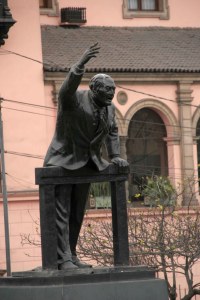
Nearby, San Martín remains in his saddle, and a long-dead orator passionately exhorts oblivious citizens.


Nearly a decade into the 21st Century, a portable typewriter can still make you some money on the streets of the city, writing for those who can’t.


When traffic slows down, vendors dance among the cars and trucks and buses, selling kites, toys, soft drinks, air fresheners, lottery tickets, and even books — though 
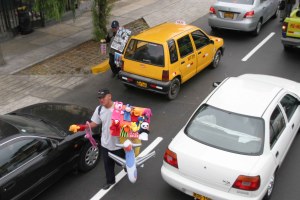 a sudden light change sometimes means sprinting a block to complete the sale.
a sudden light change sometimes means sprinting a block to complete the sale.
From the top of a bus, from my vantage point as a lone visitor who knows no one and leaves on the midnight plane, without attachments, suddenly it seems as if I can see everything, and everything I see evokes senses, even if in fact I know  nothing, not the text of the letter the typewriter man is composing for his client nor the dreams of this resting laborer, nor even the next turn in my own life, and yet everything feels quite right. I am full of reflections today, compelling ones to me but too inchoate and quirky to share.
nothing, not the text of the letter the typewriter man is composing for his client nor the dreams of this resting laborer, nor even the next turn in my own life, and yet everything feels quite right. I am full of reflections today, compelling ones to me but too inchoate and quirky to share.
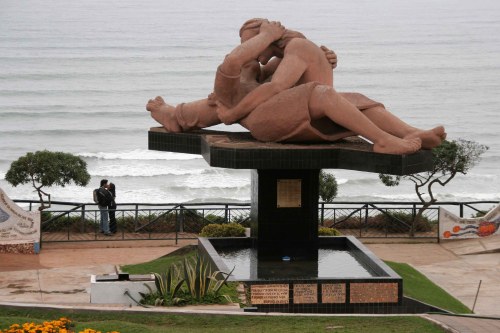
For a moment the view from the top of the bus looks as if some Great Comic Strip Writer in the Sky had drawn me these two pairs of lovers, one large and one small, one flesh and one stone, but both full of such passion as to remind me that, as I have felt at various moments in my life, love is a country that canceled my visa long ago.
I grin, a little sorry that the sunlight isn’t brighter, wondering whether the picture would be stronger or weaker in bright sunlight, but mostly grateful that this bus with this photographer clinging to the top of it paused here at just this moment.
 A familiar sight! La Rosa Nautica. Yet another view of it. But this is as close as I’ll get to it this week. It strikes me that this is my third stay in Lima, and the first not to include a supper down there. But the thought quickly gives way to curiosity whether framing three such different views of the same landmark would look at all interesting.
A familiar sight! La Rosa Nautica. Yet another view of it. But this is as close as I’ll get to it this week. It strikes me that this is my third stay in Lima, and the first not to include a supper down there. But the thought quickly gives way to curiosity whether framing three such different views of the same landmark would look at all interesting.
And then I’m back where I started. Back where the bus started this morning and the journey around Perú started more than six months ago, though rather than contemplating any of this I’m busy dialing Aldo on my Peruvian cell-phone and starting the short walk to his office building.
We have a pleasant lunch at the menu place where we’d lunched six months ago. He has with him a book of Vargas Llosa’s, in Spanish – and surprises me by telling me it’s for me. I point out that he has an optimistic view of my capabilities in Castellano. He acknowledges that, but encourages me to grow into the book.
In the evening I walk around. In Parque Kennedy it’s a nice evening, and lively. I stroll about, then find a perch and write idly in my notebook:
I sit, quite quiet and relaxed, on a bench in a park, city, and country that are not mine. it is a cool evening. There is a pleasant breeze. Vendors, lovers, chess-playhers, and conversationalists are all here doing what they do, as are children, not far away, the rusty screeches of swings more consistently audible than their screams of joy, of excitement, perhaps merely of childhood.
I am alone. Quite alone. Too, I am in a curious moment when all waves have rolled in and crashed, with their usual sound and fury, and are ebbing now, while their successors are in sight and imminent, though I cannot yet discern their shapes. This Peruvian journey is over, a sustained period of rhythmic peaks and valleys of excitement suddenly ending, a little too soon, like a disappointing orgasm. An eight-year relationship is also over, with a much louder crash. I have left the flat in Arequipa, where i felt comfortble, isolated, relaxed, and the black quatro por quatro, which was our real home these many months.
After some speculation on how it will be working in San Francisco again:
I know nothing and, for the moment, am comfortable knowing nothing.
It’s a nice night, though.
Why is one often so much more comforatble in a park where the dominant language is not one’s own?
Only night’s cool breeze
knows me now. All around, the
language is not mine.
It seems all my life people
have spoken some other tongue.
I feel very good. Quite content in my solitude. Curious about the future.
The next day all the way out to the airport, I feel more and more closely trapped in a web of sadness. Sourceless, it subtly builds its hold on me, strand by strand, before I recognize it consciously.
The truth is, I do not want to leave Perú. This Peruvian journey has been a delightful adventure, and I do not want it to end. I’d probably known that, but as I ride to the airport, check bags, and wait for departure, I feel it a lot more strongly than I’d have anticipated. I’m full of hopes for what lies next, but right now my sadness at leaving Perú is a fog that muffles the sounds and dims the lights of those hopes.
Perú has been kind to me. A few individuals have become close friends I do not want to lose, many more have shared with me a moment or two of magic or kindness, wild countryside and beautiful images are stamped as clearly on my mind as on the hard-drive full of photographs. Life here has been, more than usual, a string of steps into the unknown; and if some have brought hassles, most have brought wonder.

Posted in Uncategorized
Tagged city tour of Lima, innPeru, Lima, sculpture of lovers, skulls in catacombs
50. Cusco & Pisac
58. Cusco
The first day of October is a lazy sort of day in Cuzco. Skip this section if you’re looking for excitement.
In the morning I gab awhile with the two young Brits who are headed up to Ausungate to mountain bike for a couple of days, and with a young German couple newly-arrived, and finally with Ronald the owner of the BMW parked in the courtyard.

Ronald's moto being cleaned - not by Ronald
 He left Alaska in July. July 2007. Central America alone took him about six months, and not because he doesn’t know how to drive fast. He says border crossings usually take him a couple of hours, no more, so the paperwork isn’t too bad either. He must have an adequate source of income, because when he hits the southern tip of South America he hopes to ship the bike to Capetown and start North through another continent. I’m not sure what he’ll do when he runs out of continents.
He left Alaska in July. July 2007. Central America alone took him about six months, and not because he doesn’t know how to drive fast. He says border crossings usually take him a couple of hours, no more, so the paperwork isn’t too bad either. He must have an adequate source of income, because when he hits the southern tip of South America he hopes to ship the bike to Capetown and start North through another continent. I’m not sure what he’ll do when he runs out of continents.
I ask if he has a web-site. He says he uploads pictures for friends, but isn’t much of a writer. Disappointing, because it’d be fun to read an illustrated account of his trip, which is one I’ve long wanted to make on a motorcycle. His web-site for photos — RONALD / ALASKA -> PATAGONIA – is www.picasaweb.google.com/unerwegs. [Curiously, looking at it just now, I was drawn first to his shots of places I know well, such as San Francisco and Bryce Canyon. He has some nice shots – did a hell of a lot better in Antelope Canyon than I did!]
The sun is hitting our table, the Brits are waiting for their cab, and it’s hard to get motivated, but finally I wander down to the Plaza de Armas on my way to get my Peruvian cell-phone recharged with credit for international calls. The Plaza delays me further. I wander slowly about, just watching people and shooting a few pictures.





At first I took the girl for a tourist shooting a photograph of the nun -- but apparently she wasn't.

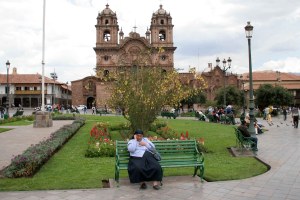



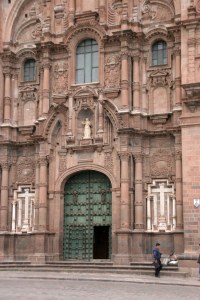 There’s a man reclining, and somewhat lackadaisically begging, in front of a church. I sit on a bench in the Plaza facing him, and shoot a few long shots to see if any interesting juxtapositions will happen along.
There’s a man reclining, and somewhat lackadaisically begging, in front of a church. I sit on a bench in the Plaza facing him, and shoot a few long shots to see if any interesting juxtapositions will happen along. 
 They don’t, and I’m too far away for good photography anyway, but I’m not moving very fast, and just then I spot a couple of well-
They don’t, and I’m too far away for good photography anyway, but I’m not moving very fast, and just then I spot a couple of well-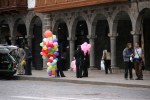 dressed young ladies with an abundance of pink balloons, moving his way from the far corner of the Plaza. When they reach him I figure that’s about as well as I’m going to do here.
dressed young ladies with an abundance of pink balloons, moving his way from the far corner of the Plaza. When they reach him I figure that’s about as well as I’m going to do here.

But as soon as I turn to leave, the shot I wanted smacks me in the face:

Returning from the Claro shop, I spot a woman begging on the sidewalk on  Avenida El Sol, and shoot a few more, wondering if any of the folks passing her will have clothing or body-language that contrasts elegantly with hers.
Avenida El Sol, and shoot a few more, wondering if any of the folks passing her will have clothing or body-language that contrasts elegantly with hers.  After awhile, having made use of her (though she hasn’t seen me), I
After awhile, having made use of her (though she hasn’t seen me), I  cross the street and give her five soles, a lot to her but affordable to me. Before re-crossing the street I ask to shoot a
cross the street and give her five soles, a lot to her but affordable to me. Before re-crossing the street I ask to shoot a  photograph of her, and shoot a portrait of her lovely, deeply-lined face.
photograph of her, and shoot a portrait of her lovely, deeply-lined face.
Back on the Plaza, and hungry for ceviche, I decide to try one of the small cafes with balconies overlooking the Plaza. I pick the El Aji [how could a New 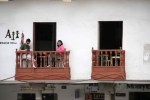 Mexican resist a restaurant named for chile?] and take a seat. The wait for the ceviche is long, but I’m in that kind of mood where everything I see down in the Plaza seems deeply evocative.
Mexican resist a restaurant named for chile?] and take a seat. The wait for the ceviche is long, but I’m in that kind of mood where everything I see down in the Plaza seems deeply evocative.
I shoot several shots of people on park benches, including one of a blonde American-looking woman reading a book. As I did with the beggars, I shoot a few more as people approach who contrast with her or might interact with her.
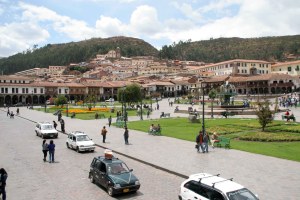



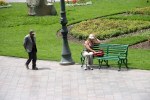
One is a small, elderly man who looks a bit down on his luck. I shoot one of him glancing at her, and wait for him to pass, but instead he plops down on the other end of the bench and quickly begins talking with her. Too far away to hear them, and not really curious about the words, I’m shooting their interaction as avidly as I shot the monkeys in trees at Lago Sandoval a few days ago – and with better results. (Gee, it’s a lot easier to take photographs from a chair on a café balcony than from a moving canoe, and when the sun’s shining on your subject rather than blocked by the branches above it.) The older man is talking animatedly, the younger woman is smiling. He reaches out his hand and they shake hands, in some intricate manner reminiscent of the way “brothers” in the U.S. used to shake hands. Then he kisses her hand. After awhile she gives him a coin or two, “because he’s alone and has nobody,” as she tells me later when I ask, and offer to send her a picture.












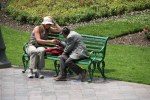













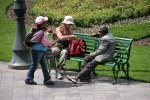

For no real reason, I keep shooting until he leaves. Or perhaps the reason is simply that I feel like it, even though I’ll toss most or all of the results away. I feel very comfortable in Cusco’s Plaza de Armas, and am in one of those moods where every face and all the body language I see seems to tell me a novel’s worth of story about the people.




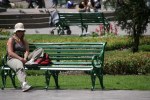

He leaves just as my ceviche finally arrives. I run out anyway for a moment, to offer to send the woman a photo of her sitting on the bench. Then I go back and start on the ceviche, which tastes good. I have been longing for ceviche for days.
I watch another American girl sit on a bench in the Plaza, and within moments a young man selling his paintings has failed to interest her in buying one but has sat down to chat with her.






When he leaves, I am nearby, shooting casual shots of people on benches, kids playing with the seagulls, and the like. She gets up and walks in my direction, and I remark, “And after all that, you didn’t buy a painting.” She says they were having Spanish/English lessons. She has just arrived, jet-lagged and sleepless, from Colorado, and has a headache. She’s hungry but figures the places on the Plaza all cost more than she feels like spending, and asks if I know somewhere. I suggest the vegetarian place where I ate yesterday. She assents. I show her where it is and have coffee with her. We have a casual but pleasant conversation, her headache dissipates, and we walk back to the Plaza, and I shoot a few last photos before returning to the hostal.



I feel surprisingly good. Refreshed, by solitude and by working on the pictures and by various pleasant conversations. I begin to think I will do the mule trek around Ausungate before I go back to Arequipa. And stop in Juliaca for a night on the way home, to shoot pictures of people there.
But in the evening a long-distance phone conversation tells me I won’t. “Real-world” work is on offer, and it appears that I should be back in San Francisco by mid-October. Wrapping up things in Arequipa, shipping Ragna’s paintings and extra stuff to her, and selling the car in Lima will take some part of the next couple of weeks, as will driving back to Arequipa and then up to Lima. I will walk around Cusco another day, watch the vice-presidential debates, then spend the next couple of weeks doing chores, writing a little, and saying good-bye to my friends.
As I work out a schedule, it starts pouring rain on the courtyard, and loud thunder interrupts my thoughts.
Thursday, 2 October
I reprise a bit of the previous day, lazing around the plaza and shooting photographs, and getting a coffee in the same balcony restaurant, El Aji. Crossing the Plaza on my way up to Plaza Nicoletas I notice a woman with a  bundle — and, as she’s walking in the same direction as I am, my camera catches this interesting juxtaposition that may be the Cusco image I’d been after the previous day:
bundle — and, as she’s walking in the same direction as I am, my camera catches this interesting juxtaposition that may be the Cusco image I’d been after the previous day:


In one of the museums, a model of the Machu Picchu area, and some photographs from back in the country, whet my appetite to return and travel further in Perú — by mule!


Near Plazoleta Nazarenas I shoot these images of tourists photographing a 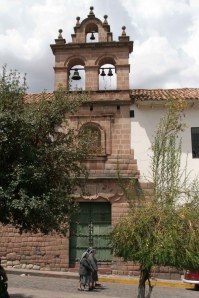 mother and daughter in local garb, and three nuns walking past an old church, then sort of combine the two. I figure I owe the mother and daughter their
mother and daughter in local garb, and three nuns walking past an old church, then sort of combine the two. I figure I owe the mother and daughter their  photography fee for the purloined images above, but have no interest in a posed shot, so I ask them just to walk a little ways beside the church wall, ignoring me. Even so, it ain’t much of a shot.
photography fee for the purloined images above, but have no interest in a posed shot, so I ask them just to walk a little ways beside the church wall, ignoring me. Even so, it ain’t much of a shot.





Cusco is a lovely place, but maybe a little too comfortable. It’s no accident that suddenly my camera focuses on these juxtapositions of wealth and poverty, pre-industrial and high-tech, local folks and gringos.
Travel Notes:
As discussed in the initial Cusco post, I liked the Hostal Q’orichaska, at 458 Nueva Alta. It’s an old building with thick stone walls, and I’d highly recommend it as a budget hotel, although the rates were a good deal more than those at the ones we saw higher up [and much further from the Plaza de Armas]. I slept marvelously every night. Calle Nueva Alta gets little late-night traffic, and almost no sound penetrated to my room [which was ground-floor and not near the front gate]. The courtyard was a great place to breakfast, or to read or gab or catch a few rays during the day, or to drink a glass of wine at night. The rooms were adequate in size and cleanliness: undecorated, but pleasant. The place was convenient to the Plaza, a very modest walk or a quick cab-ride. Hot showers, modest kitchen facilities, and Internet hookup. The staff was generally friendly and helpful, and during both the trip to Machu Picchu and the Puerto Maldonado / Corto Maltes trip we left stuff in storage there, without problems. Laundry was done and returned fairly quickly. Phone number, I think, is 228 974 – from elsewhere in Peru, preface that with (84) for Cusco; and from outside Peru, (51)(84) 228 974.
 I liked the low-budget vegetarian cafe mentioned above. It was a comfortable, informal place to hang out, the vegetarian food was tasty and nourishing, and it was relatively inexpensive. It’s on Santa Catalina, a couple of doors back toward the Plaza de Armas from Grano.
I liked the low-budget vegetarian cafe mentioned above. It was a comfortable, informal place to hang out, the vegetarian food was tasty and nourishing, and it was relatively inexpensive. It’s on Santa Catalina, a couple of doors back toward the Plaza de Armas from Grano.
 Several second-floor cafes with balcony seating beckon from above the Plaza de Armas — and both on the Plaza and down the side streets to the Northeast there are pricy restaurants with tasty food and often floor shows displaying local music, dance, and costumes.
Several second-floor cafes with balcony seating beckon from above the Plaza de Armas — and both on the Plaza and down the side streets to the Northeast there are pricy restaurants with tasty food and often floor shows displaying local music, dance, and costumes.

I also liked al grano. Good coffee, quiet during the day time, varied food – and a pool table downstairs, though I didn’t venture down to confirm that or  get a chance to go back in the evening. Place had a good feel to it though — but not cheap, at S./45 for lunch, limonada, and coffee — modest for that area of Cusco, though expensive by Peruvian standards generally.
get a chance to go back in the evening. Place had a good feel to it though — but not cheap, at S./45 for lunch, limonada, and coffee — modest for that area of Cusco, though expensive by Peruvian standards generally.
59. Cusco to Arequipa
Departure morning I’m up early and walk to the cochera, where no one’s in sight to open the place. I bang on the metal gate often and loudly, to no effect. When someone finally does return and open the place, one tire on the car is dangerously low. Fortunately there’s a gas station nearby.
Packing the car, I realize that the front seat will be empty. It is empty, save for the little cylindrical black-and-white pillow Ragna rested her knee on to limit the pain from long drives. The empty seat is a melancholy blessing: it reminds me of what has ended, but I can actually keep stuff on it during the drive. I put the pillow in the back seat. Immediately that doesn’t feel right, and I return it to its rightful place. But I don’t think I’ll start talking to it, like Tom Hanks to the soccer ball.
I say my good-byes at the Q’orichaska, negotiate the outskirts of Cusco, and am gone.
Quickly I’m in very nice countryside, on a very nice morning; but I’ve a long way to drive and a lot to think about, and don’t feel motivated to stop and shoot pictures.
 Then I do stop, to photograph a lake that probably isn’t worth it; but I’ve broken the ice, and as I pass through smaller and smaller towns, among people living their daily lives on a very nice morning, I stop here and there, to shoot a photograph or just watch and listen a little. Suddenly it seems a splendid morning.
Then I do stop, to photograph a lake that probably isn’t worth it; but I’ve broken the ice, and as I pass through smaller and smaller towns, among people living their daily lives on a very nice morning, I stop here and there, to shoot a photograph or just watch and listen a little. Suddenly it seems a splendid morning.
 At the edge of town a man is studiously reading a book, perhaps a bible. He sits in the few feet between the front wall of his house and the road. Something about his intense concentration appeals to me so much that I find a place to make a U-turn and go back. I shoot from the car. He looks up. Expressionlessly, he studies me for a
At the edge of town a man is studiously reading a book, perhaps a bible. He sits in the few feet between the front wall of his house and the road. Something about his intense concentration appeals to me so much that I find a place to make a U-turn and go back. I shoot from the car. He looks up. Expressionlessly, he studies me for a  moment, then goes back to his reading. He doesn’t appear proud, curious, annoyed, or embarrassed. He just doesn’t give a shit. I shoot another image or two, then pass him, make another U-turn, and continue on my way.
moment, then goes back to his reading. He doesn’t appear proud, curious, annoyed, or embarrassed. He just doesn’t give a shit. I shoot another image or two, then pass him, make another U-turn, and continue on my way.



It’s morning in the mountains. Sometimes high hills block the bright sun. Women are taking flocks of sheep or small groups of cows to pasture. The road,  with periodic large trucks and very few cars, snakes through as if it existed in some other dimension, some parallel universe. The trucks and occasional cars whizzing through have as little to do with the surrounding scene as football on television matters to a fish.
with periodic large trucks and very few cars, snakes through as if it existed in some other dimension, some parallel universe. The trucks and occasional cars whizzing through have as little to do with the surrounding scene as football on television matters to a fish.
 I pull off the road and sit for awhile on the rail of a bridge. It’s peaceful. I write in my notebook and
I pull off the road and sit for awhile on the rail of a bridge. It’s peaceful. I write in my notebook and  stare across the river. It’s this kind of country again: modest villages giving way quickly to steep hillsides terraced for agriculture.
stare across the river. It’s this kind of country again: modest villages giving way quickly to steep hillsides terraced for agriculture.
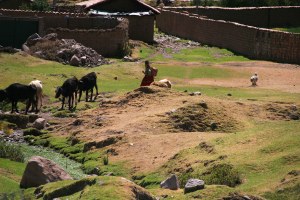 As I sit, a woman and her dog leave the village to head for the pasture with her animals. I watch.
As I sit, a woman and her dog leave the village to head for the pasture with her animals. I watch. 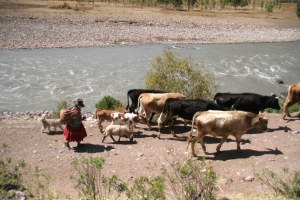 She passes just below me with her small group and continues on her way along the river — toward canyons that look pretty unpromising as far as vegetation, but she
She passes just below me with her small group and continues on her way along the river — toward canyons that look pretty unpromising as far as vegetation, but she  knows what she’s doing a good deal better than I do. I feel very much at peace, and realize I’m enjoying the drive. Again, driving enables me to stop at will; and again, although the road to Cusco is far better traveled by foreign tourists than the roads to Huancabamba or Cajamarca, small villages along the way might as well be miles from a paved road, because tour buses have no reason to stop in such places.
knows what she’s doing a good deal better than I do. I feel very much at peace, and realize I’m enjoying the drive. Again, driving enables me to stop at will; and again, although the road to Cusco is far better traveled by foreign tourists than the roads to Huancabamba or Cajamarca, small villages along the way might as well be miles from a paved road, because tour buses have no reason to stop in such places.
 Perhaps it all seems particularly precious to me because I will soon be elsewhere, in a modern, post-industrial city filled with time-sheets and lattes. I will
Perhaps it all seems particularly precious to me because I will soon be elsewhere, in a modern, post-industrial city filled with time-sheets and lattes. I will 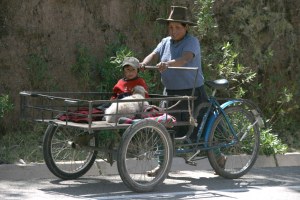 be in a city where there are no cows or sheep. Where children can grow up without ever seeing a cow or a sheep. Or perhaps it is because I felt a little melancholy and now feel, again, just wonder. “Buenos dias,” I say to the woman bicycling pass with her precious cargo. She just smiles.
be in a city where there are no cows or sheep. Where children can grow up without ever seeing a cow or a sheep. Or perhaps it is because I felt a little melancholy and now feel, again, just wonder. “Buenos dias,” I say to the woman bicycling pass with her precious cargo. She just smiles.
 Across the road some people are working in a field. A man with two oxen is plowing. Others are assisting him, or perhaps dropping seeds. I cross the road and shoot a bit. They keep on
Across the road some people are working in a field. A man with two oxen is plowing. Others are assisting him, or perhaps dropping seeds. I cross the road and shoot a bit. They keep on  doing what they’re doing. Afterward, as I’m just about to drive off, one of the men approaches me. He rubs his fingers together to indicate money. His expression is hopeful, but not demanding. I cheerfully give him a little money. He thanks me more profusely than seems warranted, and reaches into the car to shake my hand. He has few teeth but a warm smile. I tell him I thank him. I drive off, feeling good but with a couple of regrets: I should have given him more; and, selfishly, I should have stepped down into the field for a closer and better shot of them working. I had feared intruding more than I already was, but shouldn’t have worried.
doing what they’re doing. Afterward, as I’m just about to drive off, one of the men approaches me. He rubs his fingers together to indicate money. His expression is hopeful, but not demanding. I cheerfully give him a little money. He thanks me more profusely than seems warranted, and reaches into the car to shake my hand. He has few teeth but a warm smile. I tell him I thank him. I drive off, feeling good but with a couple of regrets: I should have given him more; and, selfishly, I should have stepped down into the field for a closer and better shot of them working. I had feared intruding more than I already was, but shouldn’t have worried.
 I stop in a village, possibly Checacupe, and buy bananas. The Plaza de Armas is nearly deserted. People are industriously cleaning the narrow streets leading away from it.
I stop in a village, possibly Checacupe, and buy bananas. The Plaza de Armas is nearly deserted. People are industriously cleaning the narrow streets leading away from it.
 In the next village, or maybe just in the southern end of the same village, two men are putting the grasses on the roof of an adobe building. They
In the next village, or maybe just in the southern end of the same village, two men are putting the grasses on the roof of an adobe building. They  watch me shoot from above, standing on a pile of logs, and invite me down closer. I drive into the village and back up to where they’re working, to shoot closer. No reason. Just feel like it. It’s tough to photograph, because the sun is so bright and the men’s faces – looking down and shaded by hats – are so dark.
watch me shoot from above, standing on a pile of logs, and invite me down closer. I drive into the village and back up to where they’re working, to shoot closer. No reason. Just feel like it. It’s tough to photograph, because the sun is so bright and the men’s faces – looking down and shaded by hats – are so dark.



When the man on the ladder climbs down, we chat casually for awhile. I answer  his question about where I’m from, where I started driving today and where I’m going. I remark that we use a lot of adobe in New Mexico but don’t use the sort of roof they’re working on. A neighbor, an older man, emerges from his gate and looks curiously at us. My companion hollers to him that I’m
his question about where I’m from, where I started driving today and where I’m going. I remark that we use a lot of adobe in New Mexico but don’t use the sort of roof they’re working on. A neighbor, an older man, emerges from his gate and looks curiously at us. My companion hollers to him that I’m  taking pictures, and that he should pose. The man assumes a rigid hands-at-sides posture, like a kid posing for a school photograph, and I shoot one, which seems to please him.
taking pictures, and that he should pose. The man assumes a rigid hands-at-sides posture, like a kid posing for a school photograph, and I shoot one, which seems to please him.
 Finally I leave. The neighbor assumes the same stiff posture as I drive slowly past, so I photograph him again and wish him a good day.
Finally I leave. The neighbor assumes the same stiff posture as I drive slowly past, so I photograph him again and wish him a good day.
At the turnoff for a town called Combapata, I pass an intersection busy with local folks leaving or arriving, and a sign promising a “circuit of four lakes” just six kilometers away. It sounds good, so I make a U-turn and drive into town. Within a few blocks I’m on the Plaza de Armas, which  is almost empty on the near side but has shooting galleries and foosball and other indicia of a market on the left side. A lot of people are doing something on the far side of the plaza, so I park the car for a few pictures.
is almost empty on the near side but has shooting galleries and foosball and other indicia of a market on the left side. A lot of people are doing something on the far side of the plaza, so I park the car for a few pictures.
The Plaza is full of local women in spiffy local garb. Clearly something more than a market is happening. There are a great many women with bags of local produce on show in front of them, but almost no one is actually buying anything, or even walking around looking. Many of the women are dressed particularly finely. Some other people seem to be wandering around with papers and forms. There are few men present, and no teenagers wandering around. Many of the women have small children with them. A row of chairs and a loud-speaker blasting music, with a banner on the wall behind, suggest that something more formal is going to happen soon. A Peruvian woman is rushing around photographing the local women. When I ask her what she’s photographing, she  says she’s with a program of some sort to which all these women belong, or which helps them. Something to do with development, a cooperative. The banner mentions a “Programa Nacional de Apoyo Directo a los más Pobres.”
says she’s with a program of some sort to which all these women belong, or which helps them. Something to do with development, a cooperative. The banner mentions a “Programa Nacional de Apoyo Directo a los más Pobres.”
Whatever it all means, it’s a visual paradise.

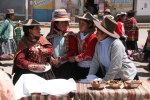










Many of the women laugh when I shoot pictures. A few turn their heads away or put a hand up in front of their faces. Others stare at me, mostly with smiles. One sticks her tongue out, then laughs hysterically, tells those around her what she’s just done, then poses good-naturedly. A couple of others, seeing me trying to shoot pictures of their kids, entice the kids back in front of me or gently turn a kid’s face in my direction. None asks for a propina.
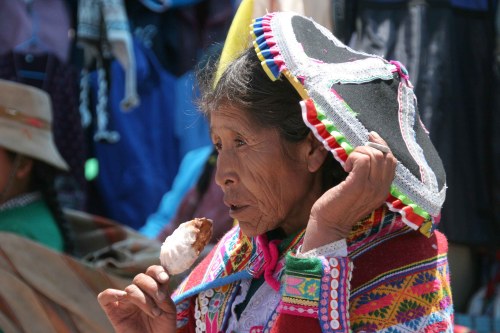 On the way to the car I stop at a booth and shoot a gun instead of the camera, winning a couple of packages of cookies that look as if they might have been in Combapata since Atahualpa’s time. Lunch.
On the way to the car I stop at a booth and shoot a gun instead of the camera, winning a couple of packages of cookies that look as if they might have been in Combapata since Atahualpa’s time. Lunch.
I go to the car, and pull around to head out of the square toward the lakes, but now the music suggests that dancing is imminent. I stop the car again and wade back into the middle of things – just as, indeed, dancing begins.

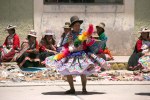


I shoot until there’s a break in the dancing, then leave.
I drive slowly through town toward the circuit of the lakes. For awhile I’m traveling along railroad tracks. Eventually the road climbs out of town and, 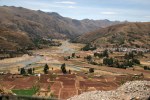 after a couple of switchbacks, there’s a nice view back
after a couple of switchbacks, there’s a nice view back  toward Combapata. From there the road continues climbing, then suddenly brings me to a view down toward a pastoral lake.
toward Combapata. From there the road continues climbing, then suddenly brings me to a view down toward a pastoral lake.
The first lake. Serene and silent. I do meet a young couple, walking toward the village. There is no car parked nearby, so they are strolling. They’re Peruvian; but they too are visitors who find this place very peaceful.


This is beautiful country. It isn’t the most dramatic I’ve seen, but it’s especially peaceful. The lakes aren’t the cobalt blue of the lakes in the Cordillera Blanca, reached ultimately through rock cliffs and surrounded by unrealistically pure white peaks, but more a lake surrounded by rolling hills and farmland, a tremendously inviting place to live. Not a person in sight, just cows grazing down by the shore and flamingo loitering about in the shallow water.
 I park the car at the edge of the road and walk toward the water, negotiating a couple of rock walls on the way. Then I find I have to leap over a small stream to reach the field that ends at the water where the flamingos are. I’m concerned that the sudden motion
I park the car at the edge of the road and walk toward the water, negotiating a couple of rock walls on the way. Then I find I have to leap over a small stream to reach the field that ends at the water where the flamingos are. I’m concerned that the sudden motion  will spook them, but it doesn’t. I advance slowly, but they’re alert. They suddenly fly up, a profusion of red and white, but they curve in unison and fly down over the lake, passing right in front of the village I was hoping to have in the background.
will spook them, but it doesn’t. I advance slowly, but they’re alert. They suddenly fly up, a profusion of red and white, but they curve in unison and fly down over the lake, passing right in front of the village I was hoping to have in the background.
Another group of flamingos floats near the shore just 60 or 80 meters away, so I I work my way toward the birds, but this time they swim away slowly as a group. I reach the water’s edge, my feet making deep indentations in the soft earth, and watch them swim out into the middle of the lake.
These flamingos are visiting with a flock of sheep. Nobody seems in any hurry about anything, so long as the two-footed intruder keeps his distance.


Alternately driving and stopping the car to walk around a bit, I don’t see another person except a shepherdess.
 She gets to sit all day in this splendid place, watching the pink and white flamingos and other birds on the blue lake, with golden fields and hills surrounding her. Does she take her surroundings for granted, and concentrate on her knitting or dream of Cusco or Lima or Paris? She certainly looks contented, but who knows?
She gets to sit all day in this splendid place, watching the pink and white flamingos and other birds on the blue lake, with golden fields and hills surrounding her. Does she take her surroundings for granted, and concentrate on her knitting or dream of Cusco or Lima or Paris? She certainly looks contented, but who knows?
This group of birds neither flies nor swims away, but begins walking along the shore away from me. They’re walking faster than I’d supposed they could, and it’s clear that if I start moving faster they’ll just fly away, so I leave them in peace.

 I drive on, but stop to say hello to a second shepherdess. I ask if I may photograph her. She nods, and says, “Plata.” It means silver, literally; but the context suggests that in this part of the country they say “plata” instead of “dinero” or “propina.”
I drive on, but stop to say hello to a second shepherdess. I ask if I may photograph her. She nods, and says, “Plata.” It means silver, literally; but the context suggests that in this part of the country they say “plata” instead of “dinero” or “propina.”
I haven’t forgotten that I’ve a long way to drive. I’m concerned about the time but deeply drawn to this peaceful and tranquil countryside. I consider driving back to Combapata, but instead continue onward, to explore. The road climbs for awhile, with a long sight of llamas at the crest of a hill, then descends toward another lake, slightly smaller and greenish instead of blue, with a small town at the far shore.
 I shoot some photos at the edge of the small town, then drive in I pause on the Plaza de Armas to figure
I shoot some photos at the edge of the small town, then drive in I pause on the Plaza de Armas to figure 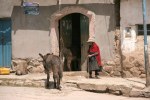 out what to do next. A woman unlocks a door and disappears inside with her three burros. The town bills itself as “Capital of the Circuit of Four Lakes.”
out what to do next. A woman unlocks a door and disappears inside with her three burros. The town bills itself as “Capital of the Circuit of Four Lakes.”
A cop or security man passes on my right, and when he glances into the car I ask him for some information. He confirms the name of the town, and I can see from the map that my choices are to circle another lake or two, to return the way I came, or to continue North several kilometers and drive back out to the main road up there. I settle on driving back the way I’ve come.
The cop points at one of the other men and says the man would like to accompany me to Sicuani. “Por que no?” I reply, starting to make space on the front seat. Ragna’s little pillow goes to the back seat now, along with my maps.
Meanwhile a local woman approaches the left side of the car, pleading. The men are discouraging her, gently urging her to stop pestering me. I suspect a class difference between my passenger, who’s wearing a blue sweater and clean shoes, and the woman, whose clothing is neither new nor fully clean. He is employed in a white-collar position, and she clearly is not. Whether or not that plays a role in their discouraging her, I can’t be sure, but they speak to her as something less than an equal.
Does she want money or a ride, or what? They say she wants a ride too. She is alone. I can fit one person in the back without an extended effort to move things out of the way. “Por que no?” I say again. I get out to open the left rear door to toss stuff to the other side and make room. The men are surprised. The woman is grateful. As we start off, the man asks where I’m from, and I answer. As we turn right off the Plaza, he greets a friend, and shouts loudly that he’s going to the United States, and we all laugh.
I take a banana and offer each of them one too. They accept. Conversation is minimal. Beautiful country. They agree. Do tourists visit here? 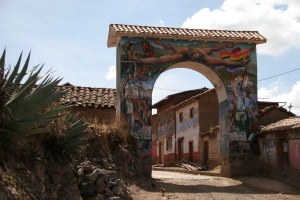
 Yes. I cannot resist detouring for a quick look at the village near the first lake. The front gate is brightly painted, but the only inhabitants I see have little to say to us.
Yes. I cannot resist detouring for a quick look at the village near the first lake. The front gate is brightly painted, but the only inhabitants I see have little to say to us.
When we reach the main road, it’s crowded with women leaving after the event. A bunch of them are climbing into the back of a huge blue truck with wooden slats on the sides, evidently to return in a group to their village.
The passenger in front, the man, is a teacher. We talk sporadically. He lives in Sicuani and teaches in the village where I picked him up. (It’s a long commute!) I answer his questions about my travels in his country and ask if he’s visited the U.S. Peruvians don’t go to the U.S., he says very definitely, adding a one-word explanation: “Plata.” I reiterate my admiration for the local countryside and inquire about land prices up by those lakes. He says lots can be as much as U.S. $7,000 apiece, sometimes can be encountered for as low as $2,000 – and that he has two for $3,000 each that he might sell.
Before Sicuani we reach Rakqi. We stop. He is enthusiastic that I must see the ruins at Rakqi. But the village is filled with tourists holding cameras but unable even to shoot a picture of the church because their own tour-buses take up most of the tiny Plaza de Armas. Handicrafts shops. I tell him I’ll return some other time. I’m thinking that sunset, somewhere, might be nice.
 I let the woman off where she lives, and the man in Sicuani, and negotiate the streets of that town. I’m sort of headed for Lampa. There’s something there I’d wanted to see on the way up, but got outvoted.
I let the woman off where she lives, and the man in Sicuani, and negotiate the streets of that town. I’m sort of headed for Lampa. There’s something there I’d wanted to see on the way up, but got outvoted.
Suddenly there looms a sign: Juliaca straight ahead, Arequipa to the right. The right turn must lead to the back roads I’d originally wanted to to take up to Cusco with Ragna and Selma, but they didn’t have time – for what promised to be a great many hours on dirt roads when the paved road would be quicker; and we wanted to go to Lake Titicaca on the way. I turn right and immediately pause to question two men standing near a motorcycle. How is the road? They say it’s much quicker, that Arequipa is much further away if you go around by Juliaca.
At first it’s paved, but quickly it’s a dirt road. The countryside is pleasant, and quite unpopulated. At some point I pass a kid near a tiny village. When I ask him whether I’m indeed on the road to Arequipa, he points — then says, “Plata.”
For a while, in the middle of nowhere, the road is beautifully paved, leading to the town of El Descanso. I stop to snag a juice, and ask the shop-keeper how many hours to Arequipa. I ask again outside, on the street. The respective answers are three hours and five hours. As soon as I leave El Descanso, the road is dirt again.
Eventually I come to a large town. In the middle of nowhere, it boasts an airport and is 3,900 meters alto, according to a sign. I don’t recognize the name the sign mentions, but I’m where I might have expected Yauri to be based on the  map. As I reach the outskirts of town, unattended llamas walk home along the road from an arduous day of grazing. The town has plenty of one-way streets and traffic jams. As I rush through, I stop for one photograph:
map. As I reach the outskirts of town, unattended llamas walk home along the road from an arduous day of grazing. The town has plenty of one-way streets and traffic jams. As I rush through, I stop for one photograph:
On the far side of town, I see a woman and ask how long it is to Arequipa. “Seis horas,” she says, quickly reconsidering and saying, “Cinco. Cinco horas.” It is a few minutes past five. I know that the paved portion of the drive, on the main road from the crossroads to Arequipa, cannot be much, so most of the drive will be along these dirt roads, often unmarked, and perhaps without grifos, or even villages. In darkness. I should have kept to my original plan. I should also have bought gas in the town through which I’ve just passed. I consider turning back, but don’t. I have a bit left in the extra gas can up top. Maybe that’ll be enough, or some town along the way will have a grifo.
Still, it’s a nice sky and vast, empty land. I rush on through late afternoon light, dusk, then darkness. There are no towns, and certainly no grifos.
In total darkness now, I reach a village. It’s cold, too. There’s a restaurant, with a bus stopped near it and passengers eating inside. I ask about gas, and am told that it can be encountered at the far edge of town.
The gas at the edge of town ain’t easy to spot. I drive to what seems like the edge of town. Nothing. I drive on, another kilometer or so, eyes scanning the night. Nothing. I return. I see a light and an open door, and look for someone to ask, but encounter only the barking of dogs. I cross the street and walk back down to a small store. The lady confirms that they do have some gas, and disappears into the back to get it. We stand in the darkness pouring gas into the car’s tank with a smaller can and a makeshift filter, hoping not too much of it ends up on my shoes.
I drive on through the night. Lightly traveled, curving roads. I was up early and feel tired. Sometimes it’s hard to pick up the road surface, which isn’t the distinct black of a paved road. In this light it’s indistinguishable from the dust and the surrounding countryside. When trucks pass, I can’t see anything anyway for a moment, in the flying dust. At some point I see a sign for Chavin, and stifle a sudden impulse to go back to Cañon de Colca.
Finally I reach the main road. I’m further from Arequipa, further back toward Juliaca, than I’d expected, possibly by 50 or 60 kilometers.
I reach Cañahaus. I could use something to eat or drink, and wouldn’t mind getting a little more gas. In the darkness I approach a road-block. The cop asks the usual routine questions, quite surprised to see a lone gringo at this time of night. I ask him if there’s a grifo around. There isn’t – but he sells me some gas. Another makeshift funnel, in pitch darkness.
Setting out again, I’m tired. I’ve traveled a long way today; I’ve shot a lot of photographs, walked a bit, and worried about possibly running out of gas or losing my way. On the other hand, I’m refreshed by the knowledge that now it’s just another 78 km. of road, paved. Still, all I really want is to be in the flat, at rest.
There’s a further delay, of course. More than half the way to Arequipa, I spot a bunch of people surrounding a car in a small turnout on the other side of the road. Folks in distress – as I might easily have been, had I missed a turn or blown a tire or missed the gas in that small town. There’s a lot of traffic tonight, but after another kilometer or so I can turn around. I drive back and pull in where they’re stopped – well aware that friends in Lima and probably Arequipa would warn me to do nothing of the kind. Ultimately I take one of the young men to the next town, the last noticeable town before the outskirts of Arequipa, and to a mecanico. I wait awhile, until it appears that they will be all right, then continue.
Fortunately I negotiate the streets into Arequipa more accurately than usual. I’m too tired to do much beyond stopping at the corner store for some snacks and milk and juice. I just want to crash. Home in the flat, there’s little time to contemplate the fact that I now live here alone — or the sadder fact that I’ll be leaving Perú very soon. I do turn on the TV, and discover a Red Sox game. Texeira is batting; but I can’t even stay awake through his at-bat.
Posted in Uncategorized
Tagged Combapata, Cusco, Cuzco, driving in Peru, driving through Peru, driving to Cusco, driving to Cuzco
57. to Puerto Maldonado and Cusco (Sept. 28-29)

 The boat from Corto Maltes back to Puerto Maldonado passes many egrets and the occasional caiman.
The boat from Corto Maltes back to Puerto Maldonado passes many egrets and the occasional caiman.
 All too soon we are there. The Canadian points out the supports for the future bridge, and we muse on how soon the bridge may be a reality and how it will change lives here.
All too soon we are there. The Canadian points out the supports for the future bridge, and we muse on how soon the bridge may be a reality and how it will change lives here.
The van drops me at the Corto Maltes office – directly across the street from the Wasai Lodge. I leave my backpack there and reserve a room.
Luci plans to take the group on a tour of the Sunday Market in Puerto Maldonado. She’s shown us a tree that produces something they call “Dragon Blood,” a somewhat miraculous cure for minor scrapes and bruises and infections, and says they sell it there. The van will stop there, then head for the Don Carlos Hotel, where Ragna and Selma are staying.
I head instead for the SUNARP office, which I’d managed to locate before we went to Corto Maltes. It’s urgent that I do some paperwork: when I bought the car, I put it in Ragna’s name and mine, and now will need her to sign off on it so that I can sell the car when I leave Perú. I’ve figured everything out except a pretty basic fact: it’s Sunday. Offices are closed.
So I grab a moto-taxi to the market to tell Ragna about this new problem.
In the market, at first I’m rushing to find Luci and Ragna and Selma, but it’s a market, and pretty soon I’m seduced by its photographic appeal. I shoot what I see: children giggling beside cages of tiny chicks, skinny chickens hanging in the air between vendors and customers, a tiny girl in a stroller wearing over-sized sunglasses and clothes that match her stroller, like some Hollywood starlet; the fresh meat and fish and the tired or laughing faces of the women waiting to sell them.










 I even shoot these videotapes — thinking of a kid I know who worked full-time on “Ratatouille.”
I even shoot these videotapes — thinking of a kid I know who worked full-time on “Ratatouille.”



Luci greets me from a few feet away before I even see them. I explain to Ragna and Selma that it’s Sunday, and that I’ll get up early on the morrow to go to SUNARP or a notario. They’ve already bought the dragon blood, and Luci waves very generally back toward wherever they bought it, then leads the others toward the van.
I decide to have a look for the dragon blood. A young man from Corto Maltes asks me if I’m lost, obviously sure I’m meant to be on the van with the others. I tell him I’m not. He asks, almost incredulously, whether I mean to stay at the market. I do.
Still shooting intermittently, I head off in the direction Luci pointed in, and ask. Early on when someone fails to recognize “dragon blood” I mime the idea and learn the Spanish phrase (since forgotten), which is more useful. Everyone knows the stuff. I get pointed in several directions, figuring I’m getting closer, and finally one man, having pointed me back toward the meat and fish vendors, decides instead to walk the few dozen meters with me, and I find myself back where I started, a few feet from where I encountered the others. A man is indeed standing by the meat and fish tables with a few small bottles, and sells me one for five soles.
Working my way back toward the corner I first arrived at, I’m hailed by a fast-talking young man who wants to sell me a native spear. I tell him that I can’t. When he asks why, I explain that I have a long way to travel, back to my country, and can’t take too much stuff. He recognizes the logic, but suggests that instead I take a picture of the indigenous man standing there with more spears and a young boy. I’m not clear on his motive. Does he think I’m going to pay him a propina for taking their photo? Is the slight mockery in his tone just good humor, or is he, as I infer, making fun of them? I decide to photograph them and pay them something. It’s an unpromising photograph, but they look like they need something. The indigenous man’s face appears full of confusion, uncertainty, timidity, as if perhaps he doesn’t come to the city often or feel comfortable here.
 So I shoot a couple of quick shots of them, then pay the indigenous man (who looks as if he might not even have asked for a propina or expected one) two soles and the boy one. After a moment the boy puts his arms around my thighs and holds me tight, leaning his head against me affectionately. I’m embarrassed by how little I gave him, touched and
So I shoot a couple of quick shots of them, then pay the indigenous man (who looks as if he might not even have asked for a propina or expected one) two soles and the boy one. After a moment the boy puts his arms around my thighs and holds me tight, leaning his head against me affectionately. I’m embarrassed by how little I gave him, touched and  saddened by how small an amount could evoke such gratitude – or perhaps more than the coin it is the unqualified friendliness he feels from me in a market where people are not treating him and his father very well. I pat his back for a moment.
saddened by how small an amount could evoke such gratitude – or perhaps more than the coin it is the unqualified friendliness he feels from me in a market where people are not treating him and his father very well. I pat his back for a moment.
Walking further, I see them again, the old man negotiating with someone to sell the half-dozen spears he’s carrying. It’s hot and muggy, and the boy should have an ice cream. I see an ice-cream vendor walking away from us. When I catch up with him I ask for two ice cream cones. One for the boy and one for his father or grandfather. The cones are a sole each. As I give him a five-sole piece I point to two children playing on the ground nearby, and ask him to give them one each, then rush away with two cones and my change. It pleases me that the two kids will have a nice surprise – and that they won’t see who’s responsible, particularly that he’s a norteamericano.
The indigenous boy and his father are still near where I’d seen them. I hand the boy a cone, then ask the man if he would like the other, and his face lights up. I hand it to him and continue on my way.
Later that evening I wonder why third-world outdoor markets still hold such appeal  for me. Okay, shooting the floating market on Inle Lake, with buyers’ shallow wooden boats just pulling up to vendors’ wooden boats for as long as the
for me. Okay, shooting the floating market on Inle Lake, with buyers’ shallow wooden boats just pulling up to vendors’ wooden boats for as long as the  transaction takes, or the Sha Ping market near Da Li, in Yunnan, with all the weird medicinal stuff and the people in traditional
transaction takes, or the Sha Ping market near Da Li, in Yunnan, with all the weird medicinal stuff and the people in traditional  costumes, sure; Lhasa, with Khampas standing around next to slaughtered yaks that haven’t even been cut up yet; even Pisac, okay. But this is a Sunday market in a city. Still, I can’t resist the faces and the tableaux, and the striking omnipresence of dead fish and animals. The moment they set me loose in it I ran around like a dog in the Gila.
costumes, sure; Lhasa, with Khampas standing around next to slaughtered yaks that haven’t even been cut up yet; even Pisac, okay. But this is a Sunday market in a city. Still, I can’t resist the faces and the tableaux, and the striking omnipresence of dead fish and animals. The moment they set me loose in it I ran around like a dog in the Gila.
At breakfast the next morning, on the deck with a view of the Mother of God River, these thoughts will morph into a couple of tanka:
how many tired faces have
how and why we struggle on.
(Finishing the second, I’ll be troubled by “we struggle on.” They struggle on – perhaps. But quite possibly their lives delight them, and it only appears, to the eyes of a spoiled gringo, that they are struggling. Maybe the weary indigenous man selling spears feels quite content with his life. I don’t know. I can’t fairly say that I struggle. “Struggle?” Sure, I’m a little down about the end of a relationship. But only a 16-year-old could seriously call going on with my life “a struggle.”
Back at the hotel, I get my stuff from behind the counter. I muse on the fact that while visiting a market where a kid was so grateful for a sole or half-sole, I left a computer, hard-drive, and extra photographic lenses in a back-pack on the floor behind the hotel counter, not ten meters from an open door to the street. Something I don’t often do. I think about all the things foreigners (and Peruvians, particularly in Lima) say about Peruvian honesty or dishonesty, and about all the hotel rooms in which maids have cleaned around stuff worth what they make in a year or two, taking nothing. All the men in remote locations who’ve grinned at me or posed for Ragna’s video-camera or asked me whether we’ve been to Cusco, without any effort to enhance their incomes by robbing us. The cab-driver in Cusco the other night who, when I automatically gave him three soles for the short ride from the Plaza to the Hostal, returned half a sole to me.
There’s some sort of parade going on, so I rush back out immediately. I rush around shooting a bunch of pictures, but the only two I like are these:


Monday morning
At breakfast I sit watching birds and listening to the boats and other sounds from the river, and write four tanka: the “Mother and daughter” tanka set in Corto Maltes, one on the indigenous man in the Sunday market, then the two more quoted above.
I assumed that the man was the boy’s father; yet in memory, a day later, he seems too old. I remember sad, weary eyes and something beaten-down about him — and hope I’ve merely imagined that.
Already feeling sweaty, I walk down Leon Velarde, one of the main streets, toward where I’d seen a sign for an abogado’s office.
The abogado’s office is empty, except for the man himself; but, as I’d guessed, it’s a notario we have to see, and he says there’s one in cuadro 7 – block 7 – and I continue walking. As I do I call the hotel to ask Ragna for her passport number. Selma comes to the phone instead, and eventually gives me the number.
The notario’s office is already full of life, with various employees of the notario helping various local folks, and other people waiting around in chairs. A woman working there explains that they can draft a document in which Ragna authorizes me to sell the car – but that when I sell it I’ll still need a copy of Ragna’s passport with an “authorization to do business” stamped in it. Which Ragna doesn’t have; but I’m pretty sure the woman’s wrong about that part of it. I start giving her the information, as well as copies of my passport and the car owner’s card, simultaneously calling back to Ragna’s hotel. Again Selma comes to the phone, and I give her the notario’s address. Moments later she shows up with the passport. While the woman copies it, Selma and I talk briefly.
The woman says they can have the document ready for Ragna’s signature quickly. Selma says they’re just packing, and can come back in a few minutes. It’s about 9:35, and I know they wanted to be off to the airport by 10. I tell her I’ll wait at the office, and do.
Time passes. I get a cold drink from a nearby stand. I stand outside and shoot  a few more photographs of passing motorcycles with families on them. I sit in the office. I review a draft of the document. I notice a change I would probably make if we were in the States – that instead of delegating me to sell the car Ragna should delegate me “or his designee,” in case I get someone else to sell it; but that seems a technicality, and I’m hot and sweaty. I try to write a tanka, but the place is too crowded and I’m out of sorts, and wondering where Ragna and Selma are, and whether I’ll get out of Puerto Maldonado today myself.
a few more photographs of passing motorcycles with families on them. I sit in the office. I review a draft of the document. I notice a change I would probably make if we were in the States – that instead of delegating me to sell the car Ragna should delegate me “or his designee,” in case I get someone else to sell it; but that seems a technicality, and I’m hot and sweaty. I try to write a tanka, but the place is too crowded and I’m out of sorts, and wondering where Ragna and Selma are, and whether I’ll get out of Puerto Maldonado today myself.
At about ten minutes past ten, I start calling Ragna’s cell-phone, then the hotel phone. When I finally reach someone at the hotel, she says they left for the airport ten minutes ago! It takes about three minutes to reach the notario’s office. I wonder whether Selma forgot the address, but she knows it’s between her hotel and the Plaza, and it couldn’t take long to cruise the dozen blocks involved. The only other notario is a little ways down this block. Meanwhile, if I don’t soon do something about my own flight, I may not get out of Puerto Maldonado today.
Still, I wait; but I am beginning to guess that Ragna’s blowing this off. It seems crazy, since I have $500 I’m supposed to give Selma, and will also be spending time and money to send Ragna’s things to her; and even without those incentives, how could you hate someone so much you’d do something that could cost him ten or twelve thousand dollars, when all you needed to do was make a two-minute stop in an office?
Did she get panicked by fears she’d miss her plane, and then her connections? Or did they get lost, lose time, and then give it up? Or does she hate me more than I imagined? She has said several times, when I’ve mentioned the car papers, that she couldn’t care less if I lose a bunch of money.
Finally I tell the woman they must not be coming back, that perhaps Ragna is angry. I walk toward the LAN office, but even then keep glancing back or pausing to watch whether any mototaxi stops at the notario’s office.
The walk is an odd low point. I’m surprisingly un-angry at Ragna, although disappointed, both in her and in my own judgment of character. I’m less troubled by the car problem than I might be: if I can’t sell it, I guess that’ll be an omen that I’m meant to move to Perú. It’d be a startling answer some day: Q. “Why’d you move to Perú?” A. “Because I owned a car down here that I couldn’t sell.”
Mostly I just feel sad. How else would one feel, ending a relationship of nearly eight years? Compound that with the distance from home, the heat and mugginess of Puerto Maldonado, the wasted morning trying to adjust the car papers, and the possibility I might not get out of town today.
The LAN office is a classic bad-news, good-news story: I tell ‘em I don’t have my ticket and guess I need to buy a new one, and they tell me there are no spaces on today’s flights and no spaces on tomorrow’s. I resolve to search more fully for the missing ticket. But when I ask which flight I was meant to be on, and my passport number confirms I’m on the second flight this morning, they point out that it’s an electronic ticket. The reason I can’t find my ticket is that I never got one, of course – and don’t need it.
I hail a moto-taxi, and the man takes me to the hotel and waits while I go to the room for my stuff. On the way, the cell-phone beeps, and the screen says I have a missed call – from Ragna’s cell-phone. For once I get through, and she asks where I’ve been. When I ask her what happened, she says they got lost, had problems communicating with their cab-driver, and couldn’t reach me. I give her the notario’s address, and tell her I’ll be back there myself as soon as I can.
The moto-taxi driver takes me back there. They’ve been and gone. The woman is doing whatever further stuff it is that she needs to do to give me an official, certified copy. Although I’m grateful they could deal with the problem at all on such short notice, the additional minutes seem awfully long. Then when I think it’s nearly over she tells me to go next door to the bookstore/stationery shop and buy a diskette, so that they can put the document on that too. I spend two or three soles for the diskette and return. Eventually she gives me the document and the diskette, and I’m off to the airport.
Of course I’m in a hurry. I should be in plenty of time for my flight, but you never know. On the other hand, if Ragna and Selma are on the earlier flight I’ll likely have missed them, and I need to give some money to Selma – and kind of want to say good-bye to them, after all the madness.
It begins to rain slightly, and the driver stops to get from the roof some flaps to place as doors to protect me from the rain. “No me importa,” I explain. He makes sure he understood me and climbs back onto his seat, mumbling something, maybe that I might find it matters a lot in a few moments when the rain becomes a torrent – which is, of course, what happens.
Soon one of my legs is soaked. Drenched in rain and sweat, I’m guessing I’ll be cold once I’m in the airport. But I’ve no time to screw around with the curtain. Then the moto-taxi stalls, and the driver removes some cover then kick starts the thing, and we’re off again. Almost everyone else in sight is diving out of sight, or driving under the roof covering a gas station’s pumps, or parking the bike and standing under a building’s eves with a notebook or newspaper over his or her head.
My driver pulls in to a gas station to put 50 centimos worth of gas in the tank, but doesn’t insist on the flaps, although I tell him sheepishly that he was right about the rain.
Now finally we’re cruising. The rain has diminished a little, and there’s less wind, so I’m not getting pelted anymore; and we’re beyond the main part of town, moving along smartly – when an ominous noise and a jerk puncture that dream. It sounds serious. A moment later, when the noise recurs, I look down and see that the chain has slipped off whatever it connects with around the rear axle. I know it’s over. Before I even get out of the moto-taxi I spot an empty one approaching from the airport.
As the new cab makes its U-turn, I ask the old driver how much I owe him. Getting rained on as he goes to inspect the damage, he’s the definition of “disconsolate.” When my question penetrates the haze – he’s surely uncomfortable, it may be that the necessary repairs will challenge him financially, and he’s losing the fare – he shakes his head and seems to indicate that he doesn’t deserve anything because he failed. However, he got me close to the airport; and earlier he drove me to the hotel and back to the notario. I repeat the question, and he aks in a low tone for five soles, and I give him ten.
Not long afterward, I’m sitting in the waiting room with Selma and Ragna.
We laugh over the day’s crossed signals. When I pass Selma the money, we laugh that it must look just like a drug deal, and joke that I should take her backpack and walk off with it, as if I’ve just purchased whatever’s inside. It’s good to laugh. The confusion and crazy rain have made moods lighter. Likely I will not see these folks again – Selma’s flying to Lima without getting off the plane. Ragna will get off in Cusco, grab some of her stuff from the hostal, then fly immediately to Lima. We’ve had harsh words. I’m glad to part laughing.
In Cusco, the hotel employees welcome me back. They are not surprised that the other two have left.
Travel Notes:
Lodging:
Two quite reasonable hotels are the Don Carlos and the Wasai Lodge. The former is at the far [South] end of the main street (Velarde) from the Plaza de Armas. The latter is on Billinghurst, the single street between the Plaza de Armas and the hill overlooking the Madre de Dios River. I liked the Wasai better — but it was awfully hot and muggy in Puerto Maldonado. I took several cold showers each night, trying to get to sleep.
The Wasai is closer to the action (overlooks the river quite near the ferry boat and the landing from which boats head up to Corto Maltes and other such places, and is just a block away from the Plaza de Armas) and has a nice view. The Don Carlos is further away — maybe a little more quiet if you don’t get a room that backs up against the yard full of barking dogs. I’d say the Don Carlos would probably appeal a little more to upscale travelers. The Wasai also organizes jungle tours and, I think, has a lodge somewhere in the jungle. I think I paid S./ 120 per night at the Don Carlos, and slightly less at the Wasai.
Food:
Other Points:
55. Puerto Maldonado II
I breakfast alone, enjoying the morning light and visiting with the green parrot who hangs around on the front terrace. Then I head for the Wasai to rent a room for the night. While I’m up at that end of town, I rent a motor scooter too. The shift system is wholly unlike what I’m used to from decades of motorcycle-riding, and seems idiotic; and I’m pretty idiotic too: I drive a block, feeling very unsafe and edgy, before I realize that something’s missing. There’s no rear-view mirror, and my uncertainty about what’s going on behind me is far from comfortable. I drive around the block, turn the scooter in, and get one with a mirror. It has two mirrors, but also a right foot-peg and rear-brake mashed too close to each other from some previous accident. Finally I’m off, back to the Don Carlos to pick up my stuff and take it to the Wasai.
My other errand besides changing hotels is to find the SUNARP office. When I bought the car in Lima, I put it in my name and Ragna’s, thinking I might be called back to the U.S. to work on a case and she’d be using or selling the car in my absence. Now I have to have her sign it back over to me alone, so that I won’t run into excessive red tape trying to sell it. Unfortunately I have no luck finding the SUNARP office.
At the Wasi, my new room has a nice view of the river. I lunch on the deck. I chat a bit with some Polish-Canadian folks on an organized tour, then read awhile and feel sleepy. The food takes forever to arrive, but tastes okay once it does. There are birds to watch, and river sounds to listen to.
I return to the room and fall asleep within minutes. A while later I awaken enough to realize I feel extraordinarily hot, but can barely make myself awaken fully, let alone move.
When I finally manage to get out of bed, I go first for an ice cream. I take a table near the window, to shoot more shots of families on motorcycles.
Then I ride the motor scooter down to the docks, determined to cross the river and see where the road goes from Triunfo.




the car safely aboard,

a motorcycle backs onto the ferry
I ride the scooter up a wooden plank onto the vehicle ferry. Of course my foreignness amuses everyone. As we approach the opposite bank, I ask the kid in the black T-shirt how much to pay, and he tells me to ask the older man who’s putting the pole in the ground to tie up to. It seems unlikely that he doesn’t know the answer, and I wonder whether he merely doesn’t know whether his boss wants to jack up the price because I’m a foreigner with a

nearly across
camera. However, after confirming that it’s just the bike and me, no passenger, the man says S./ 2.50. Both his manner and the modest price convince me that’s the normal charge. It certainly seems reasonable.
The wooden plank rests somewhat sideways on a long concrete ramp that runs up the bank at a fairly steep angle. I will need to drive down the wooden plank, then quickly turn right to drive up the steep hill. I cross the plank successfully, but in trying to slow down and turn right I manage to take a small spill. The camera’s fine, though, and the boy in the black T-shirt is there to assist me before I even stand up. I thank him, turn the bike, and head up the hill, guessing the episode probably added a little to everyone’s amusement. Hope so.
I follow the main road. It’s a hard and bumpy dirt road. I pass a few homes and businesses and a grifo, then pasture and jungle and occasional glimpses of the river. It’s a long, dull, dirt road through the jungle, quite wide and quite flat; but for the little motor scooter, it’s treacherous and difficult. It’s hard and bumpy – then soft and gravelly, as if I’m back in New Mexico riding a dirt bike, except that this thing is a beat-up scooter. Keeping vertical takes more concentration than I might have wished. Often I think I’m going down, but manage not to. Sometimes a larger vehicle passes me, and I breathe dirt (which I don’t mind) and drive nearly blind for awhile (which makes staying upright even more of a challenge).
After awhile I spot the river off to my left, and pause to shoot a couple of mediocre pictures. I can also hear a small boat’s engine, and spot the boat progressing on the river from Puerto Maldonado. I walk a few dozen yards along a path toward the river. A pack of small dogs challenges me, barking furiously, obviously defending a small home against intruders while the family is off working or visiting. They aren’t a real danger, though, so I continue far enough to get the photograph I want, then head back to the scooter.


There’s also a spot where they’ve cut down a couple of huge trees and are sawing them up. I don’t know what kind of tree it is; but the smell as I drive past is almost like that of a slaughterhouse. The human figures, who look like ants as they scurry around attending to the huge fallen tree, and the isolation and the heat and the smell combine to leave me grateful I don’t have to spend my day working there.
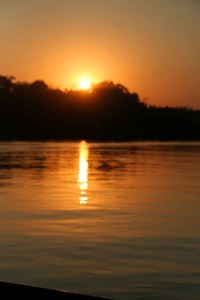 I go what seems a long way because of the conditions, but isn’t, then return in time to enjoy a jungle sunset and check on where I’m meant to be when in the morning, to leave for Corto Maltes.
I go what seems a long way because of the conditions, but isn’t, then return in time to enjoy a jungle sunset and check on where I’m meant to be when in the morning, to leave for Corto Maltes.
The Corto Maltes office is just across the street from my new hotel. They tell me I can take a morning boat or one that leaves about noon-time. Of course I choose the former, figuring I’d like to get out of the town and into the jungle as quickly as possible.
Travel Notes:
Lodging:
Two quite reasonable hotels are the Don Carlos and the Wasai Lodge. The former is at the far [South] end of the main street (Velarde) from the Plaza de Armas. The latter is on Billinghurst, the single street between the Plaza de Armas and the hill overlooking the Madre de Dios River. (Who, I wonder, was Billinghurst? Curiosity about that leads me to a photograph of the new bridge that doesn’t yet exist [see previous post] but which is described as El Nuevo Puente Billinghurst at http://www.panoramio.com/photo/2039979, although the green river in the picture doesn’t look much like the brown Madre de Dios. So I guess Billinghurst was sufficiently prominent to get the bridge named after him. Wikipedia calls it the President Guillermo Billinghurst Bridge. Further research suggests that he was elected to the presidency in August 1912, succeeding Augusto B. Leguia, and served until 1919, when Augusto B. Leguia succeeded him and served until 1930. Wikipedia adds that Guillermo Ernesto Billinghurst was born in 1851 in Arica — and that he served only until 1914. Congress wasn’t ready for his “advanced social legislation” and a military coup deposed him in 1914, when he was sent into exile to die in Iquique. He’s also described as a millionaire businessman, populist, and “reform-minded mayor of Lima” prior to his brief and turbulent presidency. “When Congress opened impeachment hearings against him he threatened to arm the workers and forcibly dissolve Congress.” It’s interesting that he’s remembered so long afterward. But Colonel Oscar Benavides, who headed the successful coup, has a main street in Miraflores named after him, while I had to get all the way to Puerto Maldonado to hear about Billinghurst. )
Probably the Don Carlos is the “better” of the two, but I liked the feel of the Wasai. It’s also closer to the Plaza de Armas, if that matters. The Don Carlos is far from everything, but if there isn’t a moto-taxi lingering outside, the folks at the desk will have one there pretty quickly for you.
Food:
At least for a fellow who doesn’t eat meat, Puerto Maldonado was not a delight — yet I got a couple of good fish suppers, one at each of the hotels. There’s a pizza place on the Plaza, and also a nice restaurant-bar on the north side of the Plaza that seemed appealing and tasteful but had no fish on the menu. I should note that I didn’t try the inviting-looking ceviche place on Velarde that I photographed every time I passed it, and that I heard tales of a couple of good restaurants not near the Plaza. Somehow evenings in Puerto Maldonado I felt too lazy to explore beyond the pizza joint.
Other:
54. Puerto Maldonado
Unfortunately, I don’t get through the metal detector unscathed. The guy starts checking me with the metal-detecting wand, and in my right pants-pocket – oops! – is the Swiss army knife that has lain there, unnoticed except when needed, for six months. Gone. Then the lady checking my bulging backpack discovers my second Swiss army knife, stashed conveniently in a small compartment and forgotten, since I haven’t lost or misplaced the one in my pocket. Two Swiss army knives gone in a moment – just when I’m going where they might be useful!
When I board the plane, there’s a family of three in the row where I’m meant to have the window seat. Too bad. But I wait patiently and do get a seat. I start reading Garcilaso.
It’s interesting reading. I recommend it. Garcilaso writes of the Incas from a unique viewpoint: his father was one of the conquistadores with Pizarro, his mother was an Inca princess, and her family taught him much about the old culture that the Spaniards did not know. He grew up in Cusco, very soon after the Conquest. Of course, being a Christian, and having moved to Spain before he was 20, he wrote with some interest in making the Inca appear no more savage than necessary to European eyes. He’s not unbiased. But his account is interesting, knowledgeable, and believed to be generally accurate. (He’s also significant as the first important Latin American writer.)
The Inca mode of conquest seems to have been to march up to the edge of your territory with a force sufficient to destroy you, then parlay. They sent in emissaries to explain why their religion, engineering, customs, and social organization were superior to anyone else’s, and point out that it would be in your interest to join the Inca empire rather than resist it. Obviously this argument was buttressed by the fact that they had brought a force sufficient to kick your ass. Still, they parlayed fairly patiently, and often conquered new territory without the need for violence. When violence did ensue, they were up to it, and ultimately prevailed; but even then they were relatively forgiving. They took your leaders to Cusco to learn to be good Inca administrators, then sent them back as such. (Even if Garcilaso exaggerates a bit, this seems to be basically accurate.)
There was one exception, which I mention not to make anyone uncomfortable but because I think it’s worth knowing, particularly among those who have questions concerning Peru’s reputation for what is now called “homophobia.” The exception: occasionally the Inca conquered a region in which homosexuality was widely practiced — or was believed to be. In this case they killed every homosexual; and the wife and children of any homosexual, if he had any; and all of his livestock; and burned his home and crops.

From the moment we land, and as we ride the noisy moto-taxi in from the airport, Puerto Maldonado is just as I imagined it – no, knew it – to be, from some haphazard collection of dreams, filmic images, and mental visions formed while reading.

 What flies past us on the way into town is not beautiful: a lot of motorcycles and moto-taxis, few cars, several grifos,
What flies past us on the way into town is not beautiful: a lot of motorcycles and moto-taxis, few cars, several grifos,  the sloppy greenery of the jungle, simple buildings
the sloppy greenery of the jungle, simple buildings  and houses, most of wood and some on stilts, and occasional food stores surrounded by motorcycles.
and houses, most of wood and some on stilts, and occasional food stores surrounded by motorcycles.
It feels different, not merely because of the lower altitude or the humidity. (The air is warmer and heavier.) This is an engaging and unpretentious place. It is quite distant, of course, from Peru’s major cities, let alone the more famous cities elsewhere. More, it feels influenced by the jungle and the climate.  None of the buildings is beautiful or elegant or complex, perhaps because one feels here that the jungle will reclaim everything soon enough. No one is dressed elegantly or drives a fine car. The muggy weather, the intermittent rain, and the mud would sabotage finery, and probably rusts cars. It seems a place not at all of indolence, but where the heat and humidity and mud and
None of the buildings is beautiful or elegant or complex, perhaps because one feels here that the jungle will reclaim everything soon enough. No one is dressed elegantly or drives a fine car. The muggy weather, the intermittent rain, and the mud would sabotage finery, and probably rusts cars. It seems a place not at all of indolence, but where the heat and humidity and mud and  jungle are too dominant to permit pretentions. The finest clothes would be stained by mud and sweat here, and the finest cars crippled by the roads and rust.
jungle are too dominant to permit pretentions. The finest clothes would be stained by mud and sweat here, and the finest cars crippled by the roads and rust.
We check in at Don Carlos’s, which overlooks the Rio Tambopata. Its most impressive feature is a green parrot who hangs around on the terrace while you are drinking coffee. It is perhaps the best hotel in town.
 Almost immediately I set out to walk to the Plaza de Armas. It is a long walk on a fairly warm Sunday. Domingo. I am alone. Almost all stores are closed. Still, I feel energized, curious about my new
Almost immediately I set out to walk to the Plaza de Armas. It is a long walk on a fairly warm Sunday. Domingo. I am alone. Almost all stores are closed. Still, I feel energized, curious about my new 
 surroundings. Too, my mood is odd: the domestic tension and uncertainty make it somber, but fresh solitude in a new place lends it a certain excitement. Traveling alone is always different from traveling in a
surroundings. Too, my mood is odd: the domestic tension and uncertainty make it somber, but fresh solitude in a new place lends it a certain excitement. Traveling alone is always different from traveling in a  group or couple: one is freer to follow chance encounters
group or couple: one is freer to follow chance encounters  where they lead, and able to munch on and digest one’s impressions before conversation dilutes them.
where they lead, and able to munch on and digest one’s impressions before conversation dilutes them.
 It’s a pleasant and solitary walk. Even with most businesses closed, the walk to the Plaza de Armas is marked by colorfully painted
It’s a pleasant and solitary walk. Even with most businesses closed, the walk to the Plaza de Armas is marked by colorfully painted 
 buildings and lively music. Children are out playing. Moto-taxis ply their trade. Toward the end of the walk, a tall statue of Mary watches over the Plaza.
buildings and lively music. Children are out playing. Moto-taxis ply their trade. Toward the end of the walk, a tall statue of Mary watches over the Plaza.



 I find a pleasant ice cream shop, and sit near a window eating chocolate ice cream and taking occasional pictures, mostly of whole families on motorcycles. This is nothing new (decades ago in Taiwan it was like that, and I was guilty of it too, carrying both my girl friend and a tall friend of ours on a little 125 cc. bike), but seems even more extreme here. Soon I also realize that a lot of the motorcyclists I see stopping for friends are actually motorcycle-taxis. The passenger climbs on the back of the bike, sans helmet, and pays a few soles for a ride.
I find a pleasant ice cream shop, and sit near a window eating chocolate ice cream and taking occasional pictures, mostly of whole families on motorcycles. This is nothing new (decades ago in Taiwan it was like that, and I was guilty of it too, carrying both my girl friend and a tall friend of ours on a little 125 cc. bike), but seems even more extreme here. Soon I also realize that a lot of the motorcyclists I see stopping for friends are actually motorcycle-taxis. The passenger climbs on the back of the bike, sans helmet, and pays a few soles for a ride.
I also spot a place to rent scooters, and resolve to do so the next day.
Around the corner from the scooter-rental shops, a pleasant-looking hotel overlooks the other river, the Madre de Dios. It’s the Hotel Wasi. I arrange to move there the following day, thus complying with Ragna’s desire to have me stay in some other hotel. The Wasi overlooks the other river, the Madre de Dios, not far from where the  ferry boats dock. I walk down there, past the sign for the local shaman.
ferry boats dock. I walk down there, past the sign for the local shaman.




 Resisting the lure of the maestro’s sign, I walk a few steps further and see an appealing
Resisting the lure of the maestro’s sign, I walk a few steps further and see an appealing 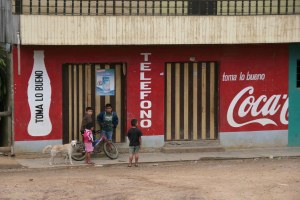 composition: a shop wall painted bright red as a Coca Cola ad, with a few children, a bicycle, and a dog approaching it. I pause, waiting for them to reach the sign, and notice the shop to my right, with very different advertisement painted on it.
composition: a shop wall painted bright red as a Coca Cola ad, with a few children, a bicycle, and a dog approaching it. I pause, waiting for them to reach the sign, and notice the shop to my right, with very different advertisement painted on it. 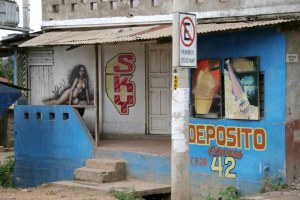

It’s a visually interesting spot, just a few meters from the entrance to the Madre de Dios ferry. I shoot a couple of shots of the kids and the Coke sign, realizing that part of its appeal is its contrasting associations for me: it’s half some Norman Rockwell picture of kids by a barn with a painted coke sign three-quarters of a century ago, and half this frontier river town in the jungle. Another motorcycle family passes them and  decides to stop and be part of the picture. It’s such a magical spot that the next motorcycle to pass actually has a family of five on it, trumping anything I shot at the Plaza.
decides to stop and be part of the picture. It’s such a magical spot that the next motorcycle to pass actually has a family of five on it, trumping anything I shot at the Plaza.
 When I reach the long stairway down to the ferry, I learn that it costs half a sole to cross. I walk up the wooden plank from the mud, to general amusement: I’m the only foreigner; in fact, I’m the only foreigner I see on any of the ferry boats I ride or see in Puerto Maldonado, except for one minibus-ful of French-Swiss people traveling with a guide.
When I reach the long stairway down to the ferry, I learn that it costs half a sole to cross. I walk up the wooden plank from the mud, to general amusement: I’m the only foreigner; in fact, I’m the only foreigner I see on any of the ferry boats I ride or see in Puerto Maldonado, except for one minibus-ful of French-Swiss people traveling with a guide.
 Note Rambo’s universal appeal. Decades ago, now, I was walking past Lhasa’s magnificent Potala Almost no one in Tibet spoke any English then, and few even spoke much Chinese.
Note Rambo’s universal appeal. Decades ago, now, I was walking past Lhasa’s magnificent Potala Almost no one in Tibet spoke any English then, and few even spoke much Chinese.  Nevertheless, among the shops and restaurants and chang spots along the street at the base of the Potala, one establishment was proudly labeled “Ranbo Bar.” The misspelling added to the effect.
Nevertheless, among the shops and restaurants and chang spots along the street at the base of the Potala, one establishment was proudly labeled “Ranbo Bar.” The misspelling added to the effect.

I’m in the mood to shoot everything I see. The boats tied up to the dock, the boats approaching from across the river, the ferryman, my fellow passengers. I’m like a child, looking at everything with wonder, and my fellow passengers seem to know that – or they’re unaccustomed to an old gringo wandering onto a passenger ferry alone. Is this another place where the tourists are all clumped together in minivans, riding the larger ferry and grouped around a guide? In any case, the men on the ferry boat greet me, grin, remark on the camera. I confess to taking a great many photographs, and as they see how true that is some of them laugh.
 Soon after we push off, I spot a huge concrete structure – at least, it looks pretty huge from a small boat on the river – that must be a support for a planned bridge over the river. I ask the boatman, who confirms that it’s for a bridge. The bridge may change his life. It must be for the Trans-_____ Highway that’ll make the drive to here, and the drive from here to Brazil, a whole lot easier. Undoubted progress I hope won’t happen too soon. I imagine
Soon after we push off, I spot a huge concrete structure – at least, it looks pretty huge from a small boat on the river – that must be a support for a planned bridge over the river. I ask the boatman, who confirms that it’s for a bridge. The bridge may change his life. It must be for the Trans-_____ Highway that’ll make the drive to here, and the drive from here to Brazil, a whole lot easier. Undoubted progress I hope won’t happen too soon. I imagine  the boatman hopes it won’t, either. It’ll probably destroy his livelihood. Intermittently I wonder how it feels to work as you’ve worked for decades, in the shadow of a concrete reminder that you will soon be obsolete.
the boatman hopes it won’t, either. It’ll probably destroy his livelihood. Intermittently I wonder how it feels to work as you’ve worked for decades, in the shadow of a concrete reminder that you will soon be obsolete.

The future looms over the bow of the ferry

Car Ferry - Rio Madre de Dios

passenger ferries waiting at Triunfo

 There is nothing special to see at the ferry-landing on the opposite bank. Just more ferry boats, more steps, a few food vendors
There is nothing special to see at the ferry-landing on the opposite bank. Just more ferry boats, more steps, a few food vendors  and what looks like a bar, and a huge logging truck. And a dirt road heading off toward wherever. Still, I walk
and what looks like a bar, and a huge logging truck. And a dirt road heading off toward wherever. Still, I walk  about, looking and listening. Then I buy a Sprite from one of the vendors — actually from a young boy spelling his mother at her stand — and sit on a rough wooden bench beside the stand.
about, looking and listening. Then I buy a Sprite from one of the vendors — actually from a young boy spelling his mother at her stand — and sit on a rough wooden bench beside the stand.

waiting
Sitting on a little unpainted wooden bench is good. My legs are old, and it gives them a rest; and it’s a kind of camouflage, allowing me to watch and listen in a lazy way, and shoot the occasional photograph; and closer around me, I have a briefly view into the lives of the vendors. The boy says nothing, but I can feel that, alternately standing and sitting behind me, he’s curious. In the next  stall a child with oddly light hair – reminding me of a Mayan girl I photographed one morning in the jungle near Bonampak – stares at me. When I photograph her, her mother watches, amused. When I approach to show the little girl her image, asking “Quien es?” in my sweetest, cajoling tone, she cries. Her mother looks at the image in the camera viewer and invites the girl to look again, but she isn’t having any, and eyes me with distrust as long as I sit there. When I turn around, the boy, whose mother has come back to the stall, is doing puzzles or something from a book. His mother leans over to help him with one, and I realize it’s a schoolbook, which he confirms when I ask. Then I notice that the dictionary is a bilingual one. He’s studying English. So I ask him
stall a child with oddly light hair – reminding me of a Mayan girl I photographed one morning in the jungle near Bonampak – stares at me. When I photograph her, her mother watches, amused. When I approach to show the little girl her image, asking “Quien es?” in my sweetest, cajoling tone, she cries. Her mother looks at the image in the camera viewer and invites the girl to look again, but she isn’t having any, and eyes me with distrust as long as I sit there. When I turn around, the boy, whose mother has come back to the stall, is doing puzzles or something from a book. His mother leans over to help him with one, and I realize it’s a schoolbook, which he confirms when I ask. Then I notice that the dictionary is a bilingual one. He’s studying English. So I ask him  about that, but he must be just beginning – or his lessons are almost purely from the printed page, and he’s had no experience actually conversing in the language yet — because even “What’s your name?” and “How are you?” draw blank stares from him.
about that, but he must be just beginning – or his lessons are almost purely from the printed page, and he’s had no experience actually conversing in the language yet — because even “What’s your name?” and “How are you?” draw blank stares from him.
It’s Sunday. Domingo. I sip my soda and enjoy life. When I finish it, now with no good reason to hang round, I descend to a ferry, and after awhile we’re headed back to Puerto Maldonado.
Now the logging truck I photographed up on the bluff is driving onto a larger car ferry, to cross the river toward wherever the logs will become boards. More consumption of rainforest trees, vital to our survival. Above, the truck full of logs was just a big thing to photograph, the biggest thing around up there, dwarfing the little houses and the motorcycles and the food stalls. On the river, it strikes me as one small part of humanity’s rape  of the rainforest. Innocuous, unnoticed, quiet, unremarkable. But part of something larger and sad. At the same time, the truck looks almost respendent for a moment in bright sunlight, carried across the river like some huge king.
of the rainforest. Innocuous, unnoticed, quiet, unremarkable. But part of something larger and sad. At the same time, the truck looks almost respendent for a moment in bright sunlight, carried across the river like some huge king.
As with certain witnesses and friends I’ve dealt with, nothing is every quite black or quite white in the rainforest.

almost home
I take a moto-taxi from the ferry area to the hotel. From the hotel I hear music, as if from some festival or perhaps a sporting event. The girl behind the desk explains that it’s a football game, a few blocks away. Having no pressing engagement, I start toward the noise.
Walking the dirt street toward the stadium, the visual surroundings are unfamiliar, but the sound and feel in the air are of a Saturday afternoon high school football game in the beautiful countryside along the Hudson River four decades ago. I am walking down uneven dirt  lanes with occasional sheep, and women gossiping in front of houses with slogans written on them, rather than the proud suburban homes of small-town North America; and the kids in short pants
lanes with occasional sheep, and women gossiping in front of houses with slogans written on them, rather than the proud suburban homes of small-town North America; and the kids in short pants  playing pick-up soccer against the wall of the stadium are not playing “one-a-cat” with a baseball
playing pick-up soccer against the wall of the stadium are not playing “one-a-cat” with a baseball 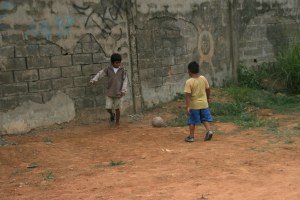 and a bat against the brick walls of Pierre Van Cortlandt Elementary School. But the energy in the air, the band music, the cheering and jeering of the crowd, are as I heard them striding toward the high school field for that different kind of football.
and a bat against the brick walls of Pierre Van Cortlandt Elementary School. But the energy in the air, the band music, the cheering and jeering of the crowd, are as I heard them striding toward the high school field for that different kind of football.
When I turn onto the street along the stadium walls, though, I am  clearly in Peru. The walls are the exceptionally tall walls Peruvians favor. But through holes, perhaps scraped into the wall for just this purpose, youths watch the distant game, as kids watched through knot-holes the major-league baseball games from Shoeless Joe Jackson’s time. And atop the high walls sit groups of men and boys, and a few women. Some have climbed, using the ridges at some levels of the wall and its natural decay. Beneath others stand wooden ladders, just high enough so that from the top rung one can pull oneself up onto the top of the all, as in a comic-strip indication of a burglary.
clearly in Peru. The walls are the exceptionally tall walls Peruvians favor. But through holes, perhaps scraped into the wall for just this purpose, youths watch the distant game, as kids watched through knot-holes the major-league baseball games from Shoeless Joe Jackson’s time. And atop the high walls sit groups of men and boys, and a few women. Some have climbed, using the ridges at some levels of the wall and its natural decay. Beneath others stand wooden ladders, just high enough so that from the top rung one can pull oneself up onto the top of the all, as in a comic-strip indication of a burglary.
I walk along, photographing the folks on the walls, and turn right to see more of them, as well as a huge delivery truck parked on the street with three men standing on top of it to watch. There are nearly as many people on top of the wall, or watching through holes or breaks in the walls, as in the stadium.
 I’m an outlaw myself. I photograph one family up there, then ask if I may move their ladder slightly to the side of them and use it to join them. Of course I may. The spectacle of a middle-aged foreigner [or shall I simply say “old” ?] climbing the wall with his camera and fisherman’s vest amuses everyone in the area. My legs are not limber, and there are four rebar rods sticking up out of the wall just where I’d like to swing my legs over to let them dangle on the football-field side, but I manage.
I’m an outlaw myself. I photograph one family up there, then ask if I may move their ladder slightly to the side of them and use it to join them. Of course I may. The spectacle of a middle-aged foreigner [or shall I simply say “old” ?] climbing the wall with his camera and fisherman’s vest amuses everyone in the area. My legs are not limber, and there are four rebar rods sticking up out of the wall just where I’d like to swing my legs over to let them dangle on the football-field side, but I manage.
The game is not right below us. Several meters within this brick wall is a chain- link fence – also high, and with wire to discourage anyone from climbing over it. Inside the smaller enclosure, a team in red is playing a team in green. Legitimate “stands” are on the side of the field to my left, and
link fence – also high, and with wire to discourage anyone from climbing over it. Inside the smaller enclosure, a team in red is playing a team in green. Legitimate “stands” are on the side of the field to my left, and  in the far corner, to the right of the field, there appears to be another small grandstand. There really do seem to be a lot more people on the fence than inside it, and snack-vendors working the
in the far corner, to the right of the field, there appears to be another small grandstand. There really do seem to be a lot more people on the fence than inside it, and snack-vendors working the  game periodically walk around the perimeter to offer their wares to the spectators on the wall. (Is a seat inside costly? Or do a lot of these folks just feel that an illicit view of the game is a whole lot more pleasurable?)
game periodically walk around the perimeter to offer their wares to the spectators on the wall. (Is a seat inside costly? Or do a lot of these folks just feel that an illicit view of the game is a whole lot more pleasurable?)
At some point I ask the girl next to me whether one team is from here and another from elsewhere, or whether these are two teams from Puerto Maldonado. “Los Rojos,” she says, are from Puno. It is a long way. The players from Puno must have flown here.
As I start shooting photographs, something brushes my left shoulder lightly. It is a man who has moved the ladder a few inches from where I left it, and climbed up to sit just the other side of the protruding rebar.
I immerse myself in shooting. The game is too far away Still, it amuses me. It is what I do. Around me the game continues, with kicks and headers and penalties, but no goals; the crowd jeers at one foul, and people toss a few things off the wall onto the grass between us and the soccer field.
At some point I grow a little tired of sitting up there watching. Although I am naturally rooting for the boys in green, I can’t pretend to care very much who wins. (I do not witness a goal and do not ask whether or not any were scored before I arrived.) I haven’t played the game for years and can’t see very well from here anyway.
I glance down for the ladder, which of course is gone. Again I think of a comic-strip burglar dangling from a second- or third-story windowsill by his fingertips, a house-painter having borrowed his ladder. There are now eight or ten more people sitting to my left on this wall, and the ladder is beneath one of them. It’s a good ways from me, there’s no possibility of standing up on this wall and trying to step over people, and it’s not clear that anyone could pass it over to us without climbing down to the ground.
Of course, as soon as I see that I can’t feasibly leave, I desire even more to get away. I am a stupid old man sitting on a wall.
To my right, the young woman also gets curious about the location of the ladder. She can’t see it, doesn’t dare lean back far enough to see how far it’s traveled, and asks her boyfriend or husband or older brother. (He’s holding the child, so I’m guessing they’re parents together.) Someone on the ground manages to recover the ladder and return it to where we are, and I gratefully descend.
 I walk back the way I came. There are even more illegal spectators than before, including a fellow who’s pulled his moto-taxi close to the wall to stand on its roof, and others who at first glance look as if they’re hanging by their crossed arms on top of the wall. The pick-up football game has six or eight players now, instead of three.
I walk back the way I came. There are even more illegal spectators than before, including a fellow who’s pulled his moto-taxi close to the wall to stand on its roof, and others who at first glance look as if they’re hanging by their crossed arms on top of the wall. The pick-up football game has six or eight players now, instead of three.
I have had a full, odd, useless day.
My room is appealing: large, and with a writing desk near the window, and a bit of a view of the river; but quickly I realize that some large population of dogs occupies the yard just below my window. The dogs aren’t happy, and are continuously barking their complaints to the world at large, and as I am unlikely to manage to solve their problems, I ask for another room. Unfortunately, the only inner room available is right next door to the ladies. I have no choice, if I hope to sleep tonight; but it is odd to hear their voices and laughter through the wall.
I eat alone in the dining room, reading Garcilaso. The meal is quite good. The television offers what will be the last major league baseball game ever played at Yankee Stadium. As a child, I hated the Yankees and was thrilled by the Dodgers’ upset win in the 1955 World Series. In my youth, I took delinquent kids to ball-games there, and drove cabs in the shadow of the stadium. Tonight it seems odd to be watching U.S. baseball, but I can’t resist doing so – at least Ragna and Selma come in. Then I retire to my room to write.
not bad; adequate rooms with desk and chairs and shelf space for clothes and other stuff; new wing appears to have rooms in some ways less charming but better-appointed than those in the old wing; and they have a view over a set of old houses or huts. Unfortunately, those houses or huts come accompanied by dogs, whose loud barking sent me begging for a new room by mid-evening. Nice folks. Friendly parrot. Quite good food. Modest view of the Rio Tambopata from some rooms and the front terrace.
For better or for worse, somewhat isolated. It’s a good hike to the Plaza de Armas, fun the first time but not something I’d want to have to do when I was in a hurry or carrying a large pack, or in the heat of a sunny day. However, there are usually mototaxis hanging around out front, and if there aren’t any the staff will send a young man to find one.
Hotel Don Carlos serves good suppers.
The Wasai Lodge is another reasonable hotel choice. I moved to it the next morning, to ensure domestic tranquility.
Other Points:
There are few cabs, but plenty of moto-taxis, and some motorcycles that function as cabs. The moto-taxis are fine, except perhaps in a sudden downpour.
Motor scooters can be rented fairly cheaply near the Plaza de Armas. There are four or five shops on one block. Be careful to make sure the one you get has rear-view mirrors and all! The first one I rented didn’t, and I didn’t notice it — and driving a motor scooter with no rear-view mirror and an unfamiliar gearshift system can be unnerving.